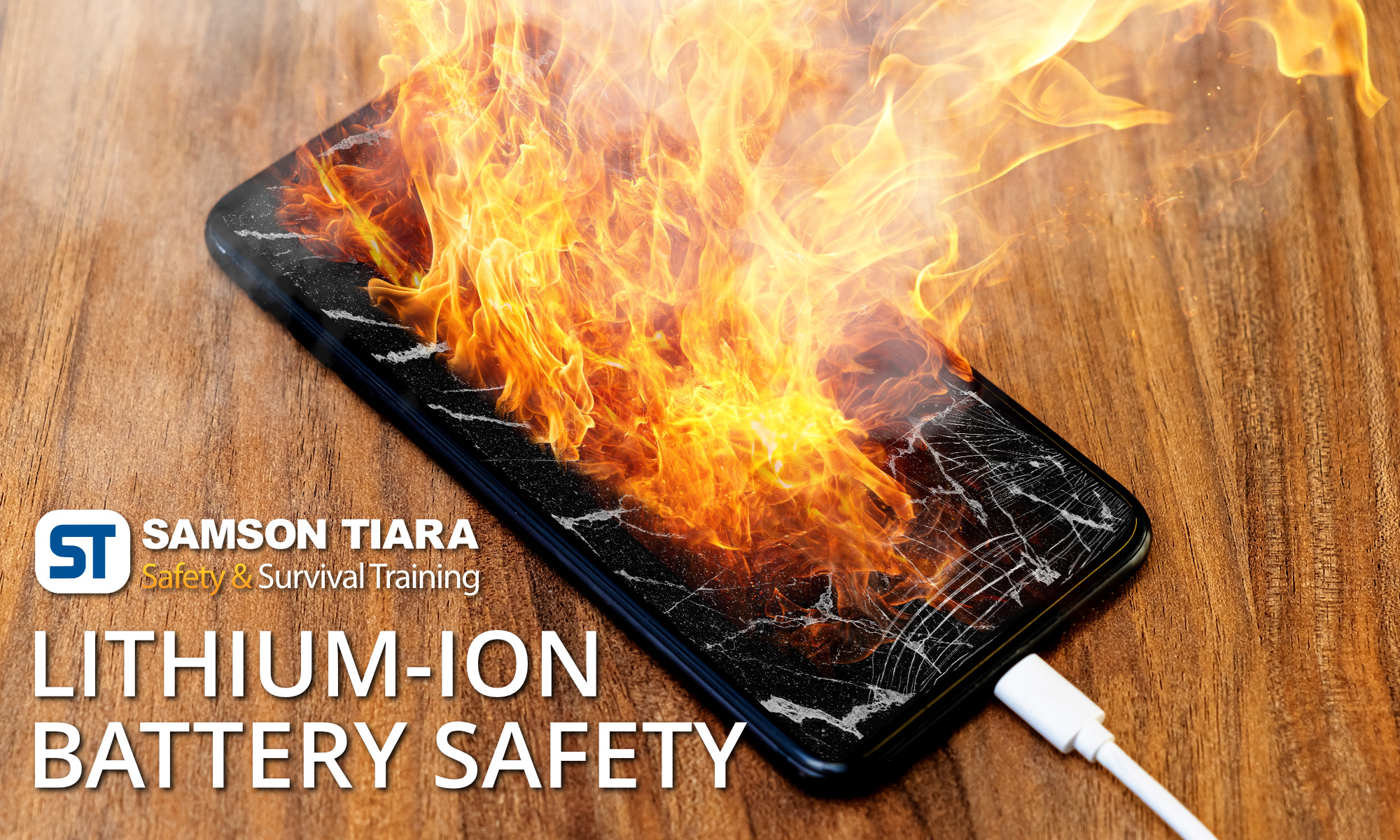Rechargeable lithium-ion (Li-ion) batteries have become an integral part of modern life, powering a wide range of devices from mobile phones and smartwatches to electric cars and scooters. While these batteries offer high energy density and portability, it is essential to understand their potential dangers and adopt best practices to ensure safety during use, charging, and storage.
Due to the widespread use of lithium-ion-powered devices, the risk associated with these batteries extends to virtually everyone. Projections from the Australian Government Competition & Consumer Commission (ACCC, 2023) suggest that by 2026, the average household will be equipped with approximately 33 devices powered by lithium-ion batteries. While lithium-ion battery fires are often deemed “rare,” it is essential to recognize that their incidence becomes notably less rare in areas with higher population densities. This is due to the sheer quantity of devices per household, underlining the importance of understanding and addressing the potential risks associated with these widely adopted batteries.
Illustrating this point, research by CBS News (Quraishi, Zalani, Beard & Mercedes, 2023) reports that between 2019 and 2022, at least 669 fire incidents attributed to lithium-ion batteries required fire department intervention in New York and San Francisco. In 2022 alone, New York witnessed over 200 such fires, most causing structural damage.
Furthermore, the Federal Aviation Administration (FAA) reported, as per Forbes (Kelleher, 2023), a minimum of 62 incidents involving lithium-ion batteries took place on aeroplanes and in airports throughout the United States in 2022. It’s important to note that this figure may not represent the total number of such incidents, as acknowledged by the FAA. Data from the FAA’s website indicates a modest decrease in 2023, with at least 50 recorded incidents.
A considerable portion of the blame for incidents is placed on unregulated aftermarket chargers, which, in many jurisdictions, are not required to undergo certification. Utilizing these chargers, especially when left unattended, has been identified as a leading cause of overcharging, subsequently triggering malfunctions, overheating, and combustion in batteries, as highlighted by numerous experts in the field (CSIRO, 2023; ACCC, 2023; Quraishi, Zalani, Beard & Mercedes, 2023).
Examples of Everyday Devices Using Lithium-Ion Batteries
Laptops
Laptops are an integral part of our professional and personal lives and predominantly utilize lithium-ion batteries for their portability and energy efficiency. To ensure safe usage:
-
- Keep Well Ventilated: Like other electronic devices, laptops can generate heat during operation and charging. Ensure that the laptop’s cooling system is unobstructed, and if using the laptop on a bed, carpet, or soft surface, consider using a cooling pad to prevent overheating.
- Avoid Extreme Temperatures: Operating or charging laptops in extremely hot or cold environments can impact battery performance. Keep your laptop in a moderate temperature range to maintain optimal battery health.
- Unplug when Fully Charged: To extend battery lifespan, unplug your laptop once it reaches a full charge. Overcharging can lead to increased heat and stress on the battery.
- Battery Health Settings: Some laptops offer built-in battery management settings. Familiarize yourself with these settings to optimize battery health. This may include features like battery-saving modes and adaptive charging.
Mobile Phones
Mobile phones are ever-present in our daily lives, and their batteries are typically lithium-ion. To ensure safe usage:
-
- Use Original Chargers: Always use the charger provided by the manufacturer or a reputable alternative designed for your specific device.
- Avoid Extreme Temperatures: Exposure to extreme temperatures, both hot and cold, can affect battery performance and safety. Avoid leaving your phone in direct sunlight, such as on the dashboard of your car, or in extreme cold.
Smart Watches
Smartwatches are becoming increasingly popular, and they often rely on compact lithium-ion batteries. To maintain safety:
-
- Regular Charging: Charge your smartwatch regularly and avoid letting the battery drain completely before recharging.
- Avoid Overcharging: Overcharging can lead to overheating. Remove the watch from the charger once it is fully charged. If available on your device, enable the smart charging feature, as this will help prevent overcharging.
Wireless Headphones
Wireless headphones, especially true wireless earbuds, commonly use lithium-ion batteries. Here’s how to ensure safe usage:
-
- Turn Off When Not in Use: If your headphones have a power-off feature, use it when not in use to conserve battery life and prevent overheating.
- Store in a Cool Place: When not in use, store your headphones in a cool, dry place away from direct sunlight.
Electric Cars
Over recent years the adoption of electric vehicles (EVs) has increased, and their propulsion systems are powered by large lithium-ion battery packs. To ensure safety:
-
- Follow Manufacturer Guidelines: Adhere to the manufacturer’s guidelines for charging, maintenance, and temperature considerations.
- Regular Inspections: Periodically inspect the battery system and follow the recommended maintenance schedule.
Electric Scooters
Electric scooters, both for personal and shared use, are powered by lithium-ion batteries. To ride safely:
-
- Charge in a Safe & Well-Ventilated Location: When charging, use a designated charging area that is well-ventilated and away from flammable materials, ideally outdoors and not in direct sunlight.
- Check for Damages: Regularly inspect the scooter for any signs of physical damage to the battery or charging components.
Dangers and Hazards
Overheating
One of the primary dangers associated with lithium-ion batteries is overheating. This can lead to thermal runaway, a rapid and uncontrollable increase in temperature that may result in a fire or explosion. Factors contributing to overheating include:
-
- Overcharging: Charging a battery beyond its capacity can generate excess heat.
- External Heat Sources: Exposure to external heat, such as leaving a device in a hot car, can contribute to overheating.
Explosion
While rare, lithium-ion batteries can explode under extreme conditions. This is typically caused by:
-
- Physical Damage: Any damage to the battery, such as punctures or dents, can compromise its integrity.
- Manufacturing Defects: Poorly manufactured batteries may have defects that increase the risk of explosion.
Thermal Runaway
Thermal runaway is a self-perpetuating reaction that occurs when a battery overheats, leading to a release of heat that further accelerates the temperature increase. This can result in a cascading failure and, in extreme cases, fire or explosion.
Common Sense Safety Precautions for Charging
Use Manufacturer-Provided Chargers
Always use the charger provided by the device manufacturer or a reputable alternative that is specifically designed for your device. Using incompatible chargers can lead to overcharging and overheating.
Avoid Overcharging
Overcharging a lithium-ion battery can lead to overheating and, ultimately, compromise safety. Unplug your device once it is fully charged and avoid leaving it connected to the charger for extended periods. If your device has a smart charging feature, ensure that it is switched on.
Charge in a Well-Ventilated Area
When charging devices, particularly those equipped with larger batteries such as electric cars or scooters, prioritize a well-ventilated environment. Adequate ventilation facilitates the dissipation of heat, significantly reducing the risk of overheating. For optimal safety, it is advisable to charge scooters outdoors, taking care to avoid direct sunlight whenever possible. This precautionary measure ensures not only effective heat dissipation but also contributes to a safer charging experience overall.
Regularly Inspect Charging Cables
Check charging cables for any signs of wear or damage. Frayed or damaged cables can pose a fire hazard. Replace damaged cables immediately and use only those provided by the manufacturer or reputable replacements.
Avoid Extreme Temperatures
Lithium-ion batteries are sensitive to temperature extremes. Avoid charging devices in excessively hot or cold environments. High temperatures can accelerate chemical reactions within the battery, while cold temperatures can decrease efficiency.
Monitor Charging Progress
If your device allows it, periodically check the charging progress to ensure everything is proceeding as expected. If you notice any abnormalities, such as unusually slow charging or excessive heat, disconnect the device and investigate the issue.
Leaving a device unattended to recharge overnight can be considered risky and unwise. The potential for unexpected issues during charging is heightened when not actively monitored. To minimize risks and promote the longevity of your device and battery, consider avoiding overnight charging without supervision.
Warning Signs of Battery Failure
Recognizing warning signs of potential battery failure can help mitigate risks. Pay attention to:
-
- Excessive Heat: If a device becomes excessively hot during normal use or charging, it may indicate a problem with the battery.
- Swelling: A swollen battery is a clear sign of internal issues. Cease using the device immediately.
- Unusual Odours: Strange smells, especially those resembling a chemical or metallic odour, can signal a malfunctioning battery.
What to Do in Case of Battery Failure or Fire
Despite all precautions, battery failures can occur. If you suspect a battery issue or witness a fire, follow these steps:
-
- Isolate the Device: Disconnect the device from its power source and, if safe to do so, move it to a safe, open area away from flammable materials.
- Call Emergency Services: If a fire occurs, call emergency services immediately. Do not attempt to extinguish a large battery fire yourself.
- Use a Class D Fire Extinguisher: If you have a Class D fire extinguisher designed for metal fires, you can attempt to use it on a small lithium-ion battery fire. However, it’s crucial to prioritize personal safety and evacuate the area.
- Evacuate and Stay Clear: In the event of a fire or battery failure, evacuate the area and maintain a safe distance. Lithium-ion battery fires can release toxic fumes.
Conclusion
In conclusion, rechargeable lithium-ion batteries have indeed transformed the landscape of powering our devices. However, understanding the potential hazards and adopting best practices is critical to ensuring safety. By following manufacturer guidelines, using original chargers, and remaining vigilant to warning signs, users can effectively mitigate the associated risks with lithium-ion batteries. Staying well-informed, exercising caution, and prioritizing safety are essential steps to responsibly enjoy the advantages of these powerful and portable energy sources.
Discover a wealth of knowledge about fire safety and the skills to combat fires through a range of comprehensive courses offered by Samson Tiara:
-
- Basic Fire Fighting (BFF): Gain foundational fire safety skills. https://www.samson-tiara.co.id/Course/Basic-Fire-Fighting/
- Advanced Fire Fighting (AFF): Elevate your fire response capabilities with advanced training.
https://www.samson-tiara.co.id/Course/Advanced-Fire-Fighting/ - Advanced Fire Fighting (AFF) by Texas A&M Engineering Extension Service (TEEX): Collaborate with TEEX for a high-calibre advanced firefighting course.
https://www.samson-tiara.co.id/Course/Advanced-Firefighting-TEEX/ - Floor/Fire Warden (Warden): Take on a leadership role in fire safety. https://www.samson-tiara.co.id/Course/Fire-Warden/
- Offshore Emergency Response Team Member (OERTM): Specialized training for handling emergencies in offshore environments. https://www.samson-tiara.co.id/Course/Offshore-Emergency-Response-Team-Member-OERTM/
- Offshore Emergency Helideck Team Member (OEHTM): Specialized training for handling emergencies on offshore helidecks. https://www.samson-tiara.co.id/Course/Offshore-Emergency-Helideck-Team-Member-or-Helideck-Fire-Fighting/
- Workplace Fire Safety (WFS): Prioritise safety in the workplace with a focus on fire prevention and response.
https://www.samson-tiara.co.id/Course/Workplace-Fire-Safety/
Sources
Australian Competition & Consumer Commission, 2023, ‘Consumers urged to use and store lithium-ion batteries safely to prevent deadly fires’, Canberra. https://www.accc.gov.au/media-release/consumers-urged-to-use-and-store-lithium-ion-batteries-safely-to-prevent-deadly-fires
Best, A., Cavanagh, K., Preston, C., Webb, A. & Howell, S., 2023, CSIRO, ‘Lithium-ion battery safety, A report for the Australian Competition and Consumer Commission (ACCC)’, May 2023. https://www.productsafety.gov.au/system/files/CSIRO-ACCCLithiumIonBatteries.pdf
Federal Aviation Administration, Lithium Battery Air Incidents. Accessed February 1, 2024.
https://explore.dot.gov/t/FAA/views/LithiumBatteries/IncidentDetails?%3Aembed=y&%3AisGuestRedirectFromVizportal=y
Kelleher, S.R., 2023, ‘FAA: Lithium Battery Incidents On Planes Now Happening More Than Once Per Week’., March 3, 2023, Forbes.
https://www.forbes.com/sites/suzannerowankelleher/2023/03/03/faa-lithium-battery-fire-smoke-airplane/?sh=61c9834ebb04
Quraishi, A., Zalani, A., Beard, R. & Mercedes, D., 2023, ‘Lithium-ion battery fires from electric cars, bikes and scooters are on the rise. Are firefighters ready?’ August 15, 2023, CBS News.
https://www.cbsnews.com/news/lithium-ion-battery-fires-electric-cars-bikes-scooters-firefighters/
Zalosh, A., Gandhi, P. & Barowy, A. 2021, ‘Lithium-ion energy storage battery explosion incidents’, Journal of Loss Prevention in the Process Industries, vol. 72, September 2021.
https://www.sciencedirect.com/science/article/abs/pii/S0950423021001686





